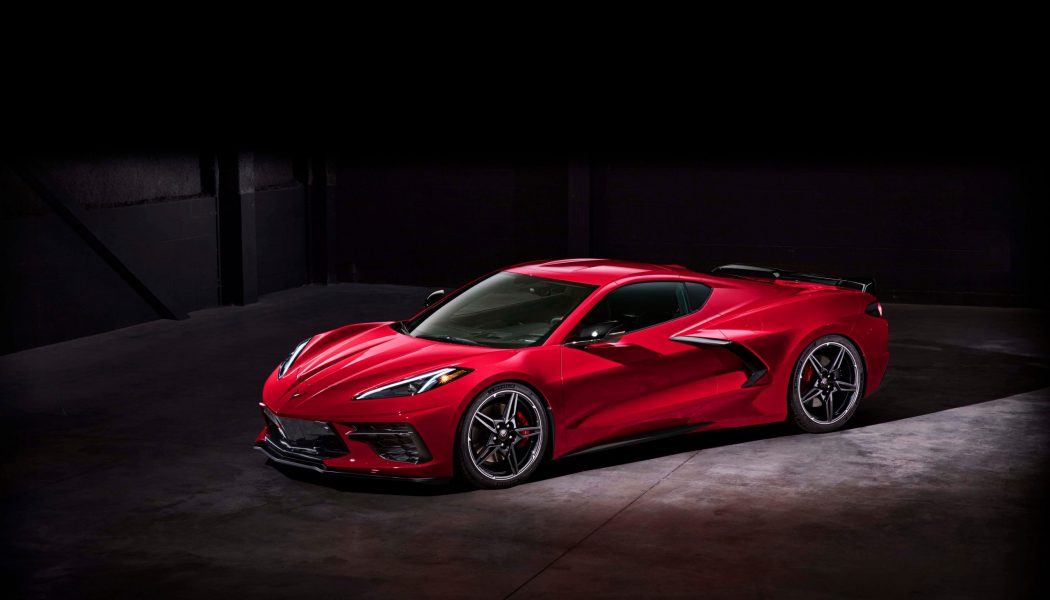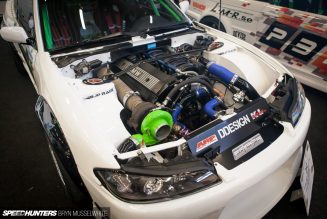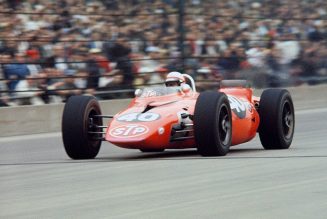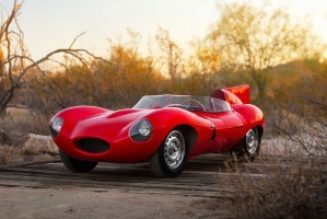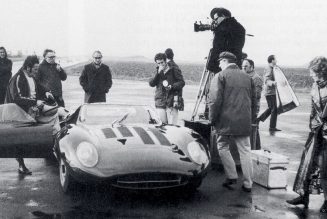Back in our December 1969 issue, we ran a story highlighting Ford and Chevrolet’s skunk works effort to develop new mid-engine supercars. With both automakers now finally offering mid-engine sports cars to the public, the Ford GT and the 2020 MotorTrend Car of The Year-winning 2020 Chevrolet Corvette, we thought it’d be fun to dive back into this old magazine story.
Detroit’s in the grip of mid-engine mania. Again, there’s said to be a mid-engine Corvette in the works, for 1972 or perhaps ’73. Ford may force Chevy’s hand with a new mid-engine machine to compete head-on with the invincible ‘Vette and, even if Dearborn defers building its own, they recently signed a deal with Alessandro de Tomaso, maker of one of today’s finest mid-engine sports cars, to Ford-power all future Mangustas and construct styling prototypes. American Motors has shown its slick AMX/2 and is rumored to be readying it for production, with the help of Giotto Bizzarini.
Sidelong glances at the latest sports car trends in Europe help convince Detroit it’s on the right track. De Tomaso’s Mangusta and Lamborghini’s Miura have been tremendously influential, because they’re big cars with big power that have strong U.S. appeal, unlike smaller mid-engine types like the Matra and Lotus Europa. When VW and Porsche announced their mid-engine 914 sports car, though, Detroit noticed. The car may not be big but the companies are.
What is (you may well ask) a mid-engine car, anyway? Is the engine somewhere in the middle, under the seats? It sounds that way, but it isn’t. “Mid-engine” is a misnomer that refers to a certain type of rear-engined car. If we accept “rear-engine” as meaning that the engine is behind the occupants of the car, which makes sense, then “mid-engine'” indicates a rear-engine car that has its power unit placed forward of the rear axle, instead of behind it. Almost all new racing cars built since 1964 have adopted the so-called mid-engine layout, which has proved to be a light, efficient way to build a car with more than half of its weight on the rear wheels. That’s why it’s attracting so much attention.
As long ago as ’62 both Ford and Chevy were out in the open with experimental mid-engine machines using less-than-mammoth engines. Chevy showed the Corvair Monza GT coupe, which differed from all others of its breed in having the engine ahead of the rear wheels. Ford unveiled its first Mustang, with a German V4 engine in mid-position and twin radiators in the rear as well.
The Mustang I, as they called it, gave Ford a place to start when they decided, in 1963, to build a team of cars for Le Mans in 1964. Out of it, through Lola and a Ford-powered GT car it had built, emerged the GT40, which has proven itself one of the greatest long-distance racing cars of all time.
With the GT40 launched, Ford executives mused, and “with all those good suspension pieces in the pipeline, why don’t we design a version for the street? We’ll make it a steel monocoque but with lower sills, and we’ll carry over a lot of scoops, vents and other styling features from the GT40. This will be four inches higher than the GT40 for more headroom,” they decided, ‘so we’ll call it a GT44.” By late 1965, Ford engineers working at Kar-Kraft had completed all the engineering details of the car, which as a mid-engine two-seater with luggage room up front and was perfect in every way but one: It cost like the dickens. So they set it aside, without even making a single GT44.
They decided to try another tack. They’d build up from a cheap car instead of down from a costly one. This, however, was a greater challenge. The starting point became a Mustang floor pan and front suspension, keeping the stock wheelbase. To this, the rear engine, new rear suspension and body had to be grafted. Major design elements fixed from the start were the 289-cubic-inch engine (later replaced by a 302) and the ZF five-speed transaxle unit, about the only one that was available off the shelf then.
To put the engine where people used to sit, designer Ed Hull: had to snip quite a hole in the back of the Mustang floor pan. He kept the boxed side rails, which kick up over the rear axle, and joined them with a big boxed crossmember at the rear and a tubular crossmember below the center of the engine. This one unbolts, to allow the engine and gearbox to drop out of the bottom. A structure of two-inch square tubes was erected at the new firewall to support the body and the upper suspension links.
Rear suspension like that of an early Lotus was used, with the driveshafts serving as lateral suspension arms, above lower links attached to the gearbox through a subframe, and with parallel trailing arms guiding the hub carriers and taking braking torque. “It wasn’t easy getting those arms past the frame rails and keeping good geometry at the same time,” Ed Hull recalled. “It took me a stack of computer printouts this high.”
Coil-shock units, around adjustable Konis, spring the Mach 2, as it was named, at the rear. No rear anti-roll bar was used on the road-trimmed car I tried, though one was included on a super-light version of the car built for track trials. This proved to be very quick, but eventually was scrapped. Like the street version, it kept the Mustang front suspension, manual steering with the quick ratio, and disc brakes. At the rear, the Mach 2 has Galaxie-size drum brakes controlled by a pressure limiting valve.
When the floor pan was chosen, a convertible type got the nod, so its stronger side sills could ensure that the package was a stiff one. Down the middle of the pan, the central tunnel that used to hold a drive line is redundant now, but it’s used to carry control pipes and water hoses back and forth. The fiberglass body, laid up at the Ford Design Center, is attached to the platform with adhesives that hold it firmly in place, yet will allow for some flexing movement.
When the Mach 2 was unveiled at the Chicago Show in ’67 it caused sharp reverberations “on the other side of town,” as the Ford folks put it. This was Chevy’s first concrete indication that arch-rival Ford might try to muscle into the Corvette market, and with an extremely sanitary car at that. Chevrolet had, however, not been napping. Many studies of mid-engine “‘Vettes had been made. Now, in May of 1967, Frank Winchell’s Chevy Research and Development Department initiated yet another one, with Larry Nies as project engineer.
Nies was given a project number, XP-880, and some objectives. Target weight was 3,200 pounds, heavy until you consider that the L-36 version of the 427 [7.0-liter] V-8 was to be the base power. Sixty0-percent was to be on the rear wheels, for the car was to prove whether or not this amount of rearward weight bias would be agreeable to an average American driver, if there is such a thing. Production cost was to be considered but so was the use of new design ideas.
If you’ve glanced at the table of specs of these two cars you’ve seen they’re amazingly alike in many ways. A big difference, though, is in the wheelbase: the Chevy is 7.3-inches shorter than the Ford. Now, it’s not easy to give a mid-engine car a short wheelbase. Ford needn’t be ashamed of 107 inches for the Mach 2; the AMX/2 design study is 105 inches wheel-to-wheel. When you add engine length to firewall thickness to driver length you come up with a minimum that’s irreducible, and in fact increases if you want to recline the driver to get more headroom! Your crucial decision comes at the front end, where you have to decide how much the front wheel wells and crossmembers will intrude on passenger foot room.
Starting from scratch on the XP-880, Chevy tried to make every inch count. The long “porcupine” engine was problem number one. Working with mockups, Larry Nies realized most of the intrusion on the passenger compartment came from the accessories high at the front of the engine, especially the water pump. So he decided to turn the engine around. The back became the front, where a slim ring gear for the starter was kept, along with a crankshaft vibration damper. This way the engine and driver could be 2-inches closer together than any other arrangement allowed.
At the new “back” of the engine the water pump was gear-driven from the top of the camshaft half-speed gear, and from the pump vee belts drove the “smog pump” and alternator. This engine reversal located the water pump as close as possible to the Corvette aluminum radiator placed across the chassis at the rear. Air flowed down through it from vents in the deck, encouraged by twin electric suction fans that ran all the time.
Sneaking around in front of the engine, angled to match the seat inclination, came the backbone-type frame of the XP-880 (later to be known as the Astro II). With the help of plastic scale models, ones which can be stress tested, the target stiffness of 3,600 pound-feet per degree in torsion was achieved. The stiffness isn’t high in relation to the 180-pound frame weight, compared to similar Lotus backbone frames, but they don’t have to open up the ‘”Y” at the back so far to fit in a wide engine. The center backbone is the stiffest part. It needed to be only 5 x 5 inches in section but was expanded to 6 x 12 inches to hold the 20-gallon fuel bladder. In the Mach II, fuel is stored in two tanks molded into the haunches behind the doors.
Nies was able to use some off-the-shelf parts in the front end: Camaro lower wishbones, knuckles, spindles and brake discs, gripped by Corvette calipers. Upper wishbones were special, as were the coil-shock assemblies. An anti-roll bar sits high above the suspension and a rack and pinion steering gear is low at the front.
Some new techniques were tried at the back, where the only Corvette-like feature is the cross leaf spring. A massive, high wishbone takes brake torque and drive thrust through a wide pivot to the hub carrier. A slim rod below it completes the rear suspension geometry. Fitted with Toronado-type universal joints at the inner ends, the drive shafts only drive.
Driving Astro II is a matter of going and stopping, with one pedal for each. It has an automatic transmission, a two-speed unit with a torque converter, an adaptation of the transaxle Pontiac used in its 326-cubic-inch [5.3-liter] Tempests in 1963. Disc brakes are used at the back wheels too, inside the Chaparral-type aluminum wheels with eight-inch rims.
The body is fiberglass, with the back section opening up to uncover the engine. Behind the. seats it’s double skinned, with panels two-inches apart and filled with urethane foam which adds both stiffness and sound insulation. The backbone-type frame allows the doors to wrap under the body, making it easier to get in. How about protection from side collisions? Built into the doors are channel-section crash bars that interlock with the cowl structure and the door latch. Both of these cars have seats that are fixed into place, making it easier to build in effective safety harnesses. For leg length the pedals are adjustable over a four-inch range in both cars.
Apart from this adjustment feature the interiors of the two cars are diametrically different in character. Ford’s is very ‘touring,’ wide and roomy with gentle seat contours and a stock dashboard without so much as a tachometer. Its only unorthodoxy is fixed side windows, for flush styling, requiring air conditioning. Chevy’s interior is much tighter, with driver and passenger braced snugly in deep seats. The dash is simple, much more that of the experimental XP-880 as it was originally intended to be.
The Chevy’s tight seats came in handy in skid pad tests to evaluate its handling. You could just stab it and steer it without worrying about hanging on. Stability tests were carried out with F70 x 15 tires all around, as being typical of street equipment. Right up to the point of sliding the Astro II understeered, calling for more and more steering lock. At the limit, the whole car would drift outward, showing not a trace of rear breakaway.
Chevy could have tried quicker steering in the Astro II, but it deliberately preferred a slower ratio, one adequate to catch and hold the car but not so fast that an inexperienced driver would be likely to dial in too much lock by mistake. The ratio also made the Chevy’s steering pleasantly light — more so than that of the Mach 2. The Ford called for more effort at the wheel at all speeds, especially when rolling slowly.
The steering may be heavy, but the grip is great. As you swing the small, padded wheel the Mach 2 bites and turns with no noticeable roll. Like the Astro II, it understeers, gently at first and more strongly as the limits are approached. When it runs out of road it does it at the front end, plowing off the corner in a way that’s safe for the street. The rear end tracks obediently.
With a mild 302 [5.0-liter] V-8 at the other end of the stiff-acting throttle cable, it wasn’t easy to get power oversteer with the Mach 2. What would it be like with a big-port Cleveland 351 [5.7-liter] V-8 in the back? Like unreal. Wider rear tires would help, because even now black lines can be laid down in first gear.
The ZF gearbox is famous for its vague shift pattern and its interlock that keeps you from skipping gears. By concentrating on the gear sequence and taking the shifts easily I had no disagreements with it. Around town the Mach 2 seldom gets out of third gear, and only on a freeway can you climb on up to overdrive fifth. The lever’s nicely located.
Driving the Mach 2 I couldn’t have detected the engine location by sound alone. There’s audible exhaust rumble inside the car, about as much as you’d hear inside a lively Mustang. But no mechanical clatter reminds you that you have an engine strapped to your back.
With its rear radiator and sloping snout, Astro II offers efficient forward visibility. There’s a luggage compartment in front, not too large but usable. The collapsed spare is at the right of the engine and there’s a stowage space on the left side, in the manner of the de Tomaso Mangusta.
Lack of luggage volume is one of the consistent complaints about sports cars with big engines ahead of the rear wheels. No one has yet come up with the perfect package layout. Lam- borghini scored with the Miura, placing the engine crossways so it took up the least amount of useful space and left a luggage box at the rear. The arrangement might work just as well with a big V8. You’d have to take out the seats to get at the spark plugs, but then you have to do that to reach the Mach 2’s distributor anyway.
A smooth, level ride can also be elusive with these cars. Taking the engine out of the nose and moving it toward the center reduces the effect of the major masses that normally helps keep a car on an even keel. This could be sensed in the Ford Mach 2, which generally rode well but picked up a “bobbing” motion, from nose to tail, over surface interruptions like tar expansion strips. A small price to pay for the handling agility that’s gained through the same change in mass location. The Mach 2 is at its very best in quick transitions from left to right turns and back again, slithering through with a minimum of overshoot and opposite lock.
What’s with these projectiles now? Between appearances on the show Circuit both of them have had more than 1,000 miles of test running, enough to measure the temper of the designs and the market. More significant, traditionally sluggish Detroit is now faced with a raft of European competitors from the Muira to the Mercedes C111 and the Porsche, models not for next year but now. Ford and Chevy stress that the Mach 2 and Astro II aren’t as advanced as their current thinking. Nonetheless, they are indeed excellent barometers of the ’71 or ’72 cars both companies will hawk. After the Mach 2, Ford did a similar design study based on the smaller Falcon/Maverick chassis platform, then moved on to an all-new mid-engine design. Chevy, with Larry Nies going over to Zora Duntov’s Corvette engineering sroup for a while, has done likewise.
Mid-engine machines are cars for drivers, not for show, machines that mesh nicely with the burgeoning class of buyers who seek distinction beyond a Z/28 but with its serviceability.
If, somewhere, there’s a serpentine stretch of road you want to conquer, one that never yielded the finger-snap-ping rhythm of the best in smooth, fast driving, hold out for a sports car that puts the engine right in your hip pocket, but don’t hold out long. You don’t have to.
